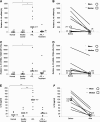The combination of arsenic, interferon-alpha, and zidovudine restores an "immunocompetent-like" cytokine expression profile in patients with adult T-cell leukemia lymphoma
- PMID: 23962110
- PMCID: PMC3751834
- DOI: 10.1186/1742-4690-10-91
The combination of arsenic, interferon-alpha, and zidovudine restores an "immunocompetent-like" cytokine expression profile in patients with adult T-cell leukemia lymphoma
Abstract
Background: HTLV-I associated adult T-cell leukemia/lymphoma (ATL) carries a dismal prognosis due to chemo-resistance and immuno-compromised micro-environment. The combination of zidovudine and interferon-alpha (IFN) significantly improved survival in ATL. Promising results were reported by adding arsenic trioxide to zidovudine and IFN.
Results: Here we assessed Th1/Th2/T(reg) cytokine gene expression profiles in 16 ATL patients before and 30 days after treatment with arsenic/IFN/zidovudine, in comparison with HTLV-I healthy carriers and sero-negative blood donors. ATL patients at diagnosis displayed a T(reg)/Th2 cytokine profile with significantly elevated transcript levels of Foxp3, interleukin-10 (IL-10), and IL-4 and had a reduced Th1 profile evidenced by decreased transcript levels of interferon-γ (IFN-γ) and IL-2. Most patients (15/16) responded, with CD4⁺CD25⁺ cells significantly decreasing after therapy, paralleled by decreases in Foxp3 transcript. Importantly, arsenic/IFN/zidovudine therapy sharply diminished IL-10 transcript and serum levels concomittant with decrease in IL-4 and increases in IFN-γ and IL-2 mRNA, whether or not values were adjusted to the percentage of CD4⁺CD25⁺ cells. Finally, IL-10 transcript level negatively correlated with clinical response at Day 30.
Conclusions: The observed shift from a T(reg)/Th2 phenotype before treatment toward a Th1 phenotype after treatment with arsenic/IFN/zidovudine may play an important role in restoring an immuno-competent micro-environment, which enhances the eradication of ATL cells and the prevention of opportunistic infections.
Figures





References
-
- Hinuma Y, Komoda H, Chosa T, Kondo T, Kohakura M, Takenaka T, Kikuchi M, Ichimaru M, Yunoki K, Sato I. et al.Antibodies to adult T-cell leukemia-virus-associated antigen (ATLA) in sera from patients with ATL and controls in Japan: a nation-wide sero-epidemiologic study. Int J Cancer. 1982;29:631–635. doi: 10.1002/ijc.2910290606. - DOI - PubMed
-
- Tsukasaki K, Hermine O, Bazarbachi A, Ratner L, Ramos JC, Harrington W Jr, O'Mahony D, Janik JE, Bittencourt AL, Taylor GP. et al.Definition, prognostic factors, treatment, and response criteria of adult T-cell leukemia-lymphoma: a proposal from an international consensus meeting. J Clin Oncol. 2009;27:453–459. - PMC - PubMed
Publication types
MeSH terms
Substances
LinkOut - more resources
Full Text Sources
Other Literature Sources
Research Materials

